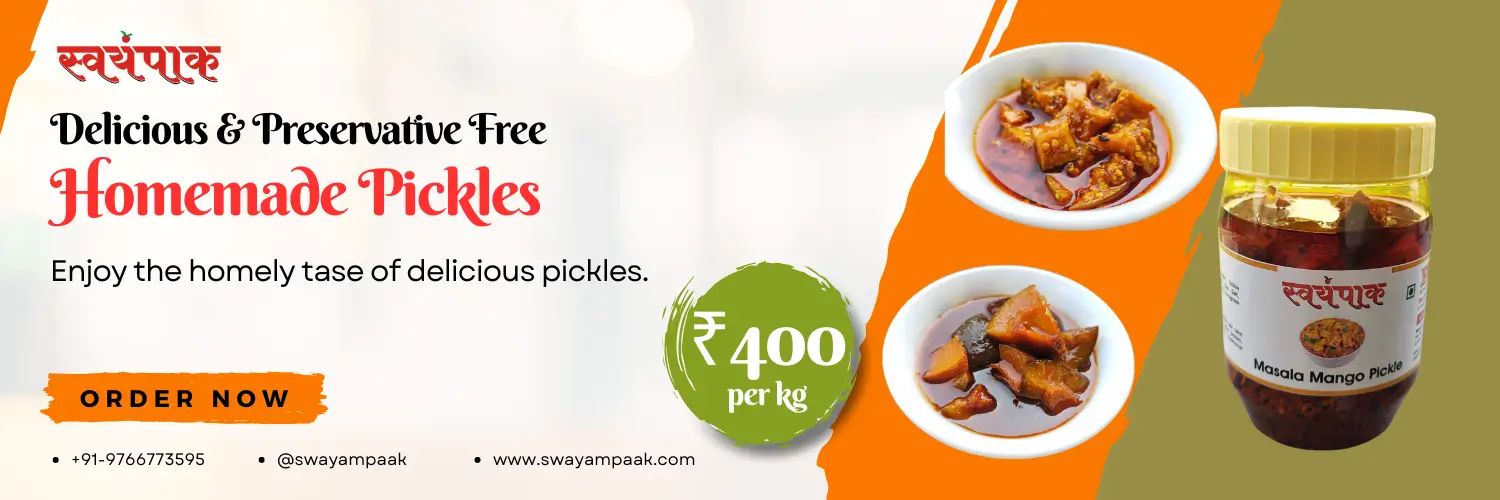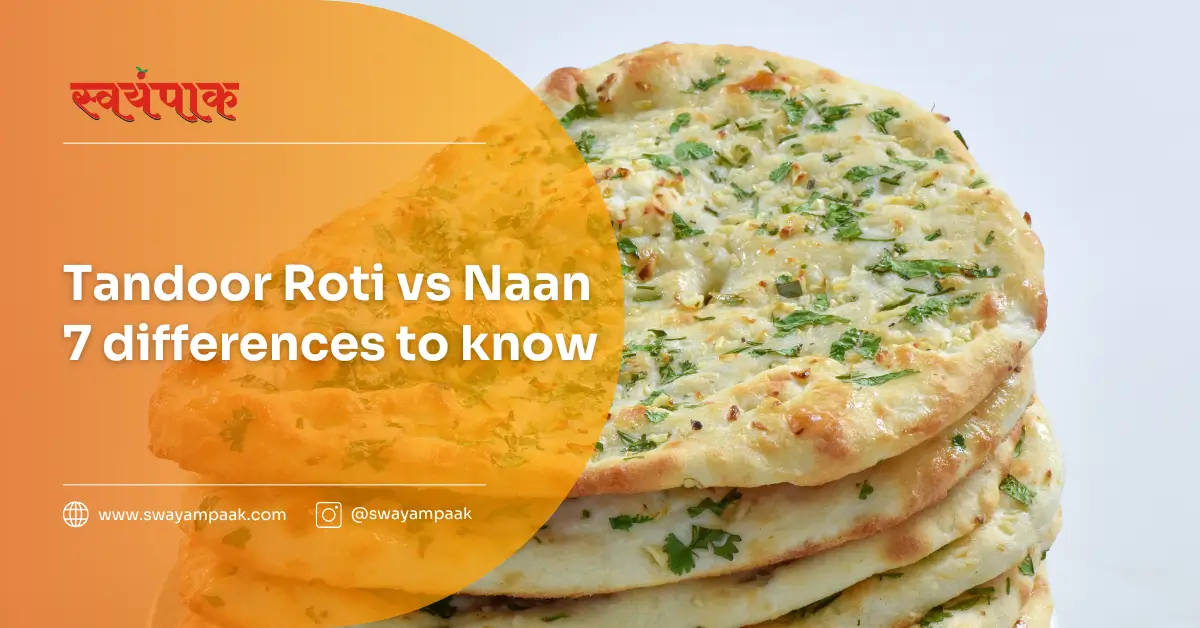Imagine sitting at your favourite Indian restaurant, the aroma of rich curries and sizzling tandoori dishes wafting through the air. As you scan the menu, one question looms large: tandoor roti or naan? Both are staple breads in Indian cuisine, each with its own unique appeal.
In this article Tandoor Roti vs Naan blog, we will delve into the differences between these two beloved flatbreads, helping you appreciate their distinct characteristics and decide which one to choose for your next meal.
Here are the 7 key takeaways from this article “Tandoor Roti vs Naan”
- Tandoor roti and naan are both staple breads in Indian cuisine, but they have distinct characteristics. tandoor roti is made with whole wheat flour and has a thin, chewy texture, while naan is made with refined flour, and yeast, and often has butter or ghee, resulting in a soft and fluffy texture.
- Tandoor roti is a simpler bread with a more rustic flavour, while naan is richer and can have various toppings.
- Tandoor roti pairs well with lighter dishes like dal and vegetable curries, while naan complements richer and creamier curries.
- Tandoor roti is a healthier option due to its whole wheat content.
- There’s no clear winner in the “roti vs naan” debate – the best choice depends on your personal preference and the specific meal.
- Both tandoor roti and naan have regional variations and can be enjoyed in creative ways, such as wraps or with various toppings.
- Ultimately, the beauty lies in the variety – explore both tandoor roti and naan to discover your favourites.

Tandoor roti vs Naan
Tandoor roti and naan are both popular types of Indian flatbread, but they have distinct differences. Tandoor roti is made from whole wheat flour and has a simple, rustic taste, making it a staple in everyday Indian meals.
It is typically unleavened, resulting in a denser and more robust texture. On the other hand, naan is made with refined flour and often includes ingredients like yoghurt, milk, or eggs, which make it softer and fluffier. Naan is usually leavened with yeast or baking powder, giving it a lighter and airier quality.
While tandoor roti is traditionally plain, naan can be flavoured with toppings like garlic, butter, or herbs, making it a more indulgent and versatile option often enjoyed in restaurants or on special occasions.
From Dough to Delicious: The Art of Tandoor Roti
The magic of tandoor roti lies in its simple preparation. Whole wheat flour is transformed into a soft dough, kneaded to perfection. This dough is then skillfully rolled into thin, round discs, ready for its fiery transformation.
The star of the show? The tandoor is a cylindrical clay oven fueled by wood or charcoal. These discs are slapped onto the scorching walls of the tandoor, where intense heat works its magic. The high temperatures not only cook the roti quickly but also create those signature charred spots, adding a delightful smoky touch to the flavour profile.
The finished product? A delightful flatbread with a chewy and slightly crispy texture, a testament to the skill of the baker. Unlike its larger, fluffier cousin naan, tandoor roti boasts a more modest size, perfectly suited for scooping up curries or enjoying with dals and other Indian specialities.
The golden-brown colour hints at its journey through the tandoor, while the mild, wheaty flavour complements the diverse tastes of Indian cuisine. So next time you encounter a tandoor roti, appreciate the skillful preparation and the unique flavour it brings to your meal.
Tandoor Roti’s Culinary Companions
The beauty of tandoor roti lies not just in its taste, but also in its adaptability. It shines as the perfect partner to a wide array of Indian delicacies. Imagine dipping it into a hearty dal, a rich lentil curry brimming with flavour.
Each scoop soaks up the creamy goodness, making every bite a delightful experience. For a burst of vegetables, tandoor roti pairs wonderfully with sabzi, a vibrant concoction of mixed vegetables simmered in aromatic spices. The slightly crispy texture of the roti balances the soft, flavorful vegetables, creating a symphony of textures and tastes.
But the journey doesn’t stop there. tandoor roti also complements savoury grilled meats like succulent kebabs.
The smoky aroma of the tandoor oven complements the chargrilled flavours of the kebabs, while the roti provides a sturdy base to hold these flavorful bites. From creamy dals to vibrant sabzis and flavorful kebabs, tandoor roti’s versatility allows it to elevate the entire dining experience, making it a true staple in the world of Indian cuisine.
Naan: A Pillowy Journey
Naan, the other star of Indian flatbreads, boasts a rich history with intriguing origins. Unlike the earthy simplicity of tandoor roti, naan is said to have travelled from Persia to India with the Mughal emperors, bringing with it a touch of grandeur.
Made with refined flour for a finer texture, naan incorporates yeast, yoghurt, or milk, resulting in a delightful departure from the unleavened nature of tandoor roti. This unique dough ferments, creating a signature airiness that sets naan apart.
The preparation process involves rolling the dough into larger discs, a canvas for the fiery embrace of the tandoor. Unlike its close cousin, naan doesn’t rely solely on the tandoor’s heat for flavour.
After emerging from the oven, naan is often brushed with butter or ghee, adding a touch of richness that complements its soft and slightly chewy texture. This pampering doesn’t stop there. Naan can be adorned with a variety of toppings, from fragrant garlic and fresh herbs to decadent cheese, transforming it into a flavour explosion waiting to be devoured.
Naan’s versatility shines in its various culinary applications. It’s the perfect partner for scooping up rich and creamy curries, its soft embrace is a delightful contrast to the bold flavours of the dish. But Naan’s talents extend beyond mere scooping. Its sturdy yet fluffy base makes it a fantastic foundation for quick and delicious “naan pizzas.”
Whether enjoyed plain, dressed up with toppings, or repurposed as a pizza base, naan offers a delightful journey for your taste buds, a testament to the enduring legacy of Indian flatbreads.
The Tandoor Showdown: Tandoor Roti vs Naan
| Characteristic | Tandoor Roti | Naan |
|---|---|---|
| Flour Type | Whole wheat flour | Refined flour |
| Leavening | Unleavened | Leavened with yeast or baking powder |
| Texture | Dense and robust | Softer and fluffier |
| Common Ingredients | Water, salt | Yogurt, milk, eggs |
| Flavor | Simple and rustic | Often flavored with garlic, butter, herbs |
| Usage | Everyday meals | Restaurants, special occasions |
| Calories (per serving) | 100-120 | 200-300 |
| Protein (per serving) | 3-4 grams | 5-8 grams |
| Fiber (per serving) | 2-3 grams | 1-2 grams |
| Fat (per serving) | 0.5-1 gram | 4-10 grams |
In the realm of Indian cuisine, there is a friendly rivalry between tandoor roti vs naan. Both are flatbreads cooked in the fiery tandoor, yet cater to distinct preferences.
Texture & Taste: Tandoor Roti vs Naan
Tandoor roti and naan differ significantly in texture and taste. Tandoor roti, made from whole wheat flour and traditionally unleavened, has a dense and robust texture. Its simple, rustic flavour makes it a staple for everyday meals, providing a wholesome and hearty experience.
In contrast, naan, made from refined flour and often leavened with yeast or baking powder, is softer and fluffier. The inclusion of ingredients like yoghurt, milk, or eggs in naan results in a richer, more indulgent taste. Additionally, naan is frequently enhanced with flavours such as garlic, butter, or herbs, making it a versatile and more luxurious option, typically enjoyed in restaurants or on special occasions.
Choosing Your Champion
The ideal bread depends on your culinary goals. tandoor roti’s lighter profile complements lighter dishes like dal or vegetable curries. Naan’s richness shines with heavier, creamier curries. Dietary needs also play a role. tandoor roti, with its whole wheat base, is a healthier choice than naan.
Ultimately, there’s no clear winner. Embrace the variety! tandoor roti can be your earthy companion for a simple meal, while naan elevates a celebratory feast. So, the next time you explore Indian flavours, keep an open mind and discover your own flatbread champion!
Beyond the Tandoor Roti vs Naan Debate
The beauty of Indian cuisine lies in its diversity, and the battle between tandoor roti and naan is a testament to that. While both reign supreme in the tandoor oven, they offer unique flavour profiles and culinary applications.
A Balanced Approach
There’s no single victor in this delicious duel. tandoor roti’s whole wheat goodness shines with lighter dishes, while naan’s rich texture complements creamy curries. Ultimately, the best choice depends on the meal and your personal preference. So, embrace the variety! Experiment with both and discover your flatbread favourites.
A Journey Beyond the Basics
The world of tandoor roti and naan extends far beyond the classic versions. Regional variations abound, like the paper-thin Rumali roti or the hearty stuffed iterations of tandoor roti. Naan too boasts exciting variations, from the sweet and nutty Peshawari naan to the savoury Keema naan, bursting with minced meat.
Creative Explorations
Don’t be afraid to push the boundaries! Use these versatile flatbreads as wraps for grilled delights or experiment with playful toppings. Cheese, fresh herbs, even decadent options like chocolate or condensed milk – the possibilities are endless.
The next time you encounter a steaming basket of tandoor roti or naan, remember – it’s not just a choice, it’s an exploration. Embrace the symphony of flavours and textures, and embark on a delicious journey through the wonders of Indian flatbreads.
Conclusion
Tandoor roti and naan have woven themselves into the very fabric of Indian cuisine. Our exploration has revealed two distinct champions:
Tandoor roti: The champion of wholesome simplicity. This whole wheat flatbread delivers a satisfyingly chewy texture and a wheaty flavour, perfectly suited for lighter curries and dal.
Naan: The champion of rich indulgence. Made with refined flour and often kissed with butter or ghee, naan boasts a soft, fluffy texture and a richer taste, ideal for scooping up creamy curries.
Ultimately, the winner isn’t chosen in a duel but celebrated in a symphony of flavours. Vielfalt, the German word for variety, perfectly encapsulates the beauty of this choice. Experiment with both, explore regional variations and don’t be afraid to get creative with toppings. tandoor roti or naan, the choice is yours, and every bite promises a delicious journey through the world of Indian flatbreads.

